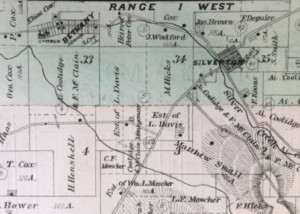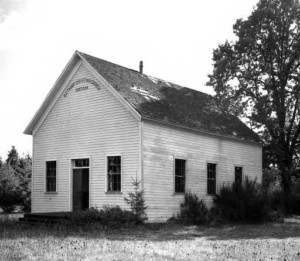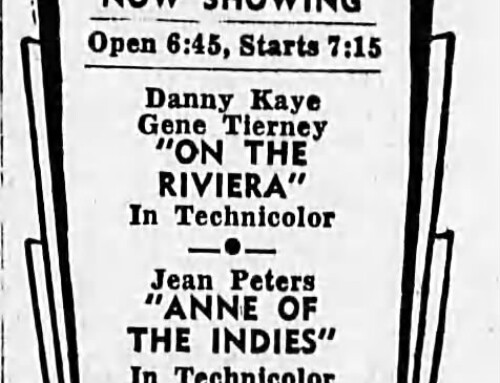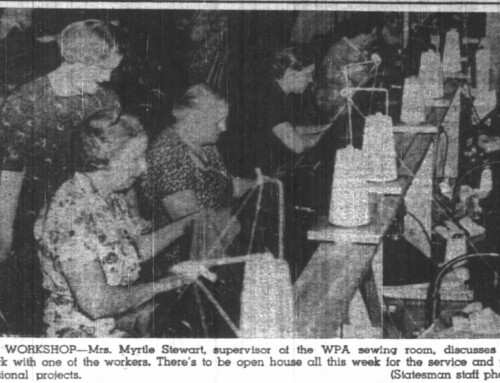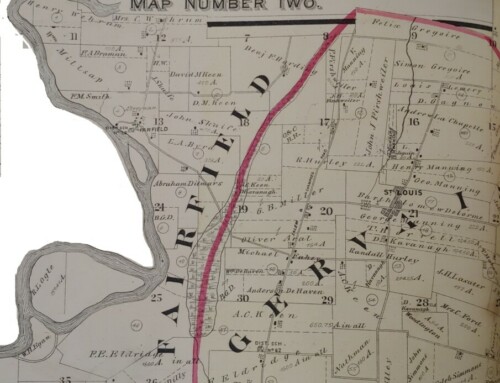Along the banks of Silver Creek in the late 1840s two twin communities took hold, Bethany and Silverton. The older by a few years, Bethany’s roots date to the arrival of brothers Gideon and Peter Cox, immigrants of 1846. Readers of local history may be more familiar with their historically famous brother Thomas Cox who established the first store in Salem. In 1847 Thomas brought his merchandise over the Oregon Trail in thirteen specially built covered wagons each drawn by three to four teams of oxen. On reaching the summit of the Cascade Mountains along the Barlow route, the goods were transferred to 60 pack horses belonging to Indians in the vicinity of Bethany – Silverton that had been secured by his brothers Gideon and Peter. Quite an undertaking at the time.
Bethany was an ambitious rival of Silverton in pioneer Oregon days with the backing of the Cox family and Thomas Shaw, future assessor, sheriff and judge of Marion County. The town was platted with 56 blocks that lay on both sides of the county road just north of Silver Creek, present day Hazelgreen Rd. A number of businesses took hold including a chair factory, blacksmith shop, general merchandise store, and doctor’s office.
The community took its name from the Biblical home of Lazarus, Mary and Martha, friends of Jesus. It was in Bethany that Jesus stayed the week before his crucifixion and resurrection. As such, it is fitting to note that the first church in Bethany was organized on Easter Sunday in April 1851 at the home of Elias Cox. C.C. Chapman served as its first pastor and original membership included Wilburn and Marcella King, Margaret Miller, Fredrick Mascher, Mary Ann Robinett, Josephine Shaw, Samuel and Sara Tucker, Mary Davis, Isaac and Margaret Hedrick, Elias Cox, Illy Cox, Peter, Gideon, Susannah, Samuel, Harriet and Joseph Cox, George and Julian Woolen and Jane Shaw. By 1858, the congregation had prospered enough to build a church building.
In 1863, Elias Cox and wife officially donated the land for the church and cemetery. Included within the deed was the phrase “to have and to hold for ever and ever.” In the 1880s, the original building was deemed too large so Jennings Smith with donated laborers cut it in two and remodeled it. For years this served as a pioneer meeting place until the Church of Christ was organized and built in Silverton in the early 1900s. Then the church at Bethany was no longer needed and in April of 1942 it was demolished.
The first record of school being held in Bethany dates to 1854. Classes were held in the home of Elias Cox, then moved to the Bethany Christian Church after it was finished in 1858. There is also a brief reference of school being held in Thomas Shaw’s store building for a short period. In 1865, the community met to organize a school district and began raising funds for a school building on land donated by the Cox family. The original building boasted a bell, woodshed, hand dug well, and platform for the teacher’s desk. In 1910 a second room was added onto the west. In 1948 an auditorium. Many additions over the years transformed it into the structure used today by Bethany Charter School.
The founders of Bethany also aspired to build a college. Surely that would solidify their place on the map and eclipse their twin Silverton to the East. Land was set aside directly across from the present school for Bethany College which would be managed by the Christian church. The college was incorporated by father and son, Peter and Elias Cox, Thomas Shaw, and the Reverend Glen O. Burnett. Brick was burned for the building when two factors came into play that would cause it to be abandoned. The first, Reverend Burnett removed his support and allied himself with the second Bethel College located in Polk County west of Lincoln. The second, the lack of financial means.
On the west side of the original church building lay the cemetery on land also donated by the Elias Cox family. In early days the cemetery and church bore the name Silver Creek. It was not until 1863 when the Cox family officially deeded the land to the church that the name was switched to Bethany. The earliest recorded burial was Gemma Cox on March 7, 1850. Other burials may have taken place prior to that, but Gemma’s name is the first to appear in the grave register. On January 23, 1899 the cemetery was officially incorporated by Joshua Bowen, Peter Bowen, and Peter Cox and its name changed from Silver Creek to Bethany.
Later, in September of 1956 the American Legion began a renovation of the long-neglected cemetery. With the consent of lot owners, grave curbs were removed to make the cemetery easier to maintain, fallen tombstones removed, the older section cleared of brush, and the area prepared for seeding.
The cemetery remains to this day along with the modernized school as the last vestiges of pioneer community Bethany, finally eclipsed by her younger twin Silverton.
This article was written by Kaylyn Mabey for the Statesman Journal where it was printed 21 April 2019. It is reproduced here with sources for reference purposes.
Sources:
- “Chance Puts Bethany, Established Prior to Silverton, in Community Class While ‘Rival’ Grows Large”, Oregon Statesman, 30 Oct 1931, p. 3
- “Powell Meet to Be Sunday – Kinsmen Circuit Riders to Gather at Bethany’s Ancient Church”, Oregon Statesman, 21 Jun 1934, p. 8
- “Pioneer Church Being Razed”, Oregon Statesman, 5 Apr 1942, p. 11
- “Renovation of Bethany Burial Ground at Silverton Started”, Capital Journal, 15 Sep 1956, p. 3
- “Better Appearance Planned for Bethany Cemetery”, Capital Journal, 15 Sep 1956, p. 3
- “Bits for Breakfast – Cox Family”, R.J. Hendricks, Oregon Statesman, 5 Dec 1936, p. 4
- Plat Map of Bethany – Silverton, 1878 Illustrated Historical Atlas Map: Marion and Linn Counties, Map 5
- Marion County Pioneers: A Study of the Inhabitants Listed in the 1850 Federal Census, Shirley H. O’Neill (Cox family)



